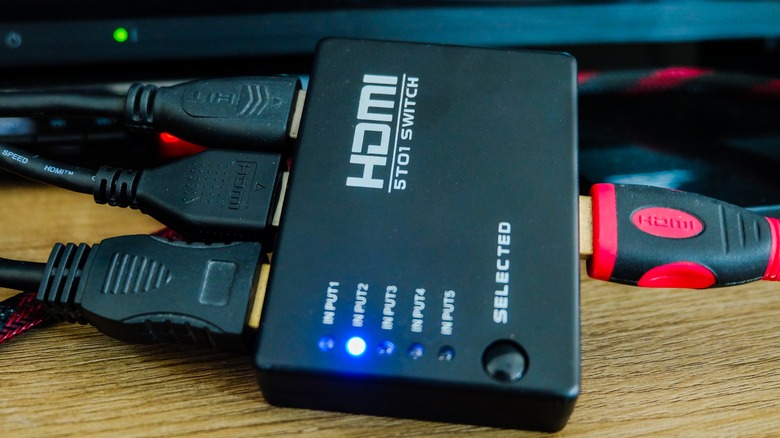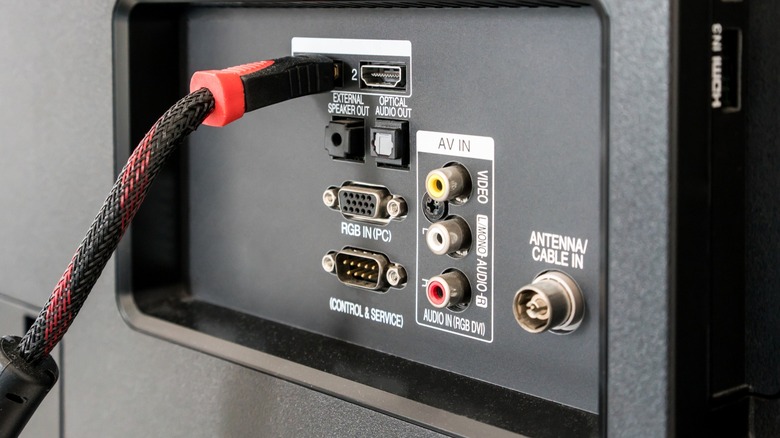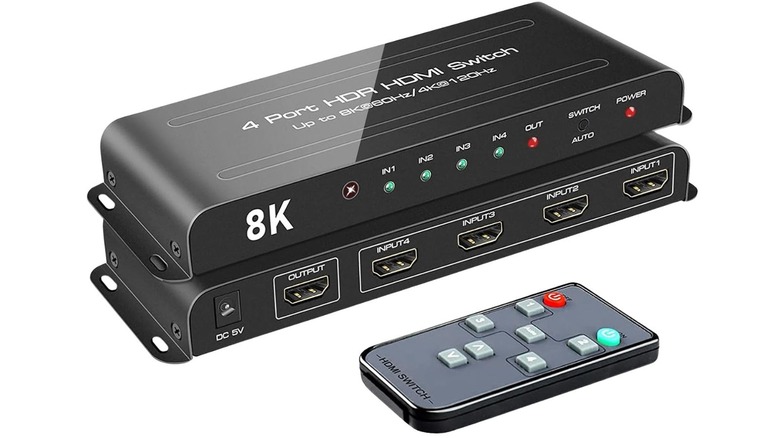How To Connect More HDMI Devices To Your TV
We may receive a commission on purchases made from links.
Video game consoles, streaming sticks, and DVD players all have one very important thing in common: they require an HDMI connection to your television. Most modern TVs have anywhere from two to four HDMI ports, which is likely more than enough for the average household. However, if you're a gamer or have a rather hefty entertainment setup, you'll exceed those ports and need an alternative option. Rather than buy a new TV, though, you can keep the same unit and use an HDMI switch.
An HDMI switch is an attachment for your television that allows you to plug multiple HDMI-compatible devices into one port. Where your HDMI 1 input may have just been for your Xbox Series X, it can now be for your Switch, PS5, older Xbox model, and Roku stick. Instead of changing the input on your TV, with a switch, you'll change it on the box that all HDMI output cables are routed through.
There are several different switches available, some capable of transmitting 4K and others equipped to handle four or more inputs. When deciding on an HDMI switch, the first question to answer is how many HDMI-compatible devices you own. To avoid playing with any input channels on the TV, it's best to get a switch that can house all of your devices. So if you have a TV with three inputs, and you have four devices, just get a four-port switch to make life easier.
Different types of HDMI switches
Along with the number of ports available, HDMI switches can have different features that make them more appealing. While most modern switches are likely to achieve 4K resolution, you may still find cheaper alternatives that top out at 1080p. Along with resolution, switches may have varying refresh rates, with some only capable of 30Hz and others reaching 120Hz. It's a matter of preference, though if you want the best picture, you'll want an 8K/120Hz-compatible switch. Other things to consider are supported audio or music formats, like Dolby Atmos and Dolby Digital, the availability of HDR, and the version of HDMI cable (2.1, 2.0, etc.) the switch can read.
You may also find passive and active HDMI switches, which can directly affect the quality of the picture transmitted. A passive switch is a simple component that requires no external power source. It connects to your TV and devices and transmits the signal it receives. Active switches have an external power source and can enhance the signal. For example, if you have an active 4K switch but are transmitting from something that only reaches 1080p resolution, the switch may upscale it for a better image.
Finally, some HDMI switches require you to change the input with a remote. Others will automatically switch based on the device being used. So, if you end the night playing your PS5 and start the day using your Xbox, the switch can automatically select the output being used.
Best-rated HDMI switches
HDMI switches aren't created equal. Some go above and beyond to deliver a quality customer experience, while others fall short of being worth their cost. If you typically shop by brand name, you're a little out of luck here, as you won't typically find a notable electronics manufacturer. So, to ensure you're buying one of the best HDMI switches, you may have to look at customer reviews. Monoprice does have a few user favorites, like the Blackbird 4K 3x1 HDMI 2.0 Switch. Compatible with HDMI devices, the switch supports HDR and transmits up to 4K/60Hz. Its 4.5-star rating comes with some critiques, mostly about how it doesn't work with PS4 consoles. However, that may have more to do with the limited power running through the PS4's HDMI cable.
Other switches to consider include OREI's bidirectional 4K HDMI switch, which boasts a rating of more than 4.5 stars from more than 4,800 reviews; Kinivo's 4K HDMI Switch and its 4.2 stars from 17,000 reviews; or the ROOFULL 4-Port 8K HDMI 2.1 Switch, which appealed to over 1,800 users who felt it earned a five-star review. Each model is an active switch that would work with all modern devices. The biggest difference between them is the number of available ports. The OREI is the smallest, with two HDMI inputs, and the Kinivo can support three. The ROOFULL is the biggest, with four HDMI ports.


